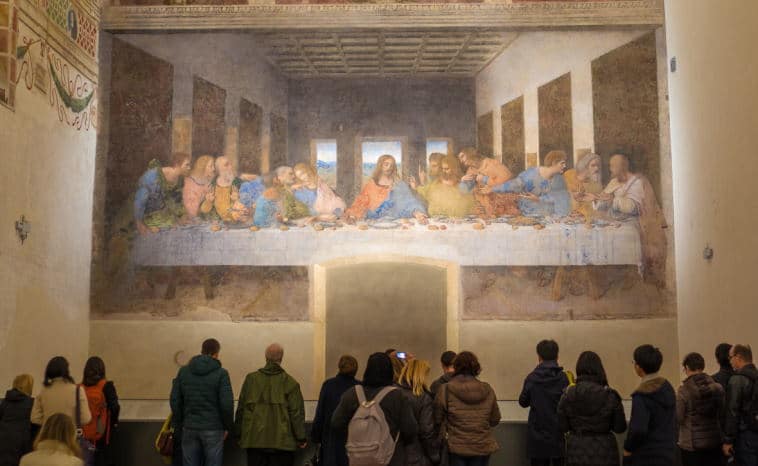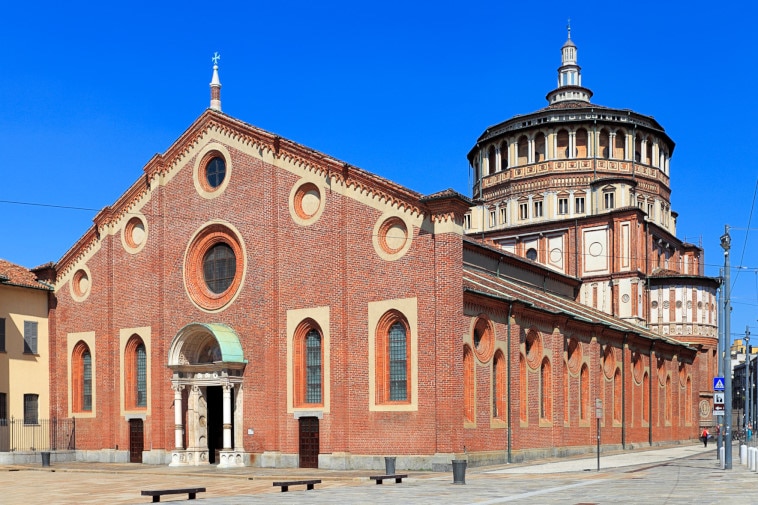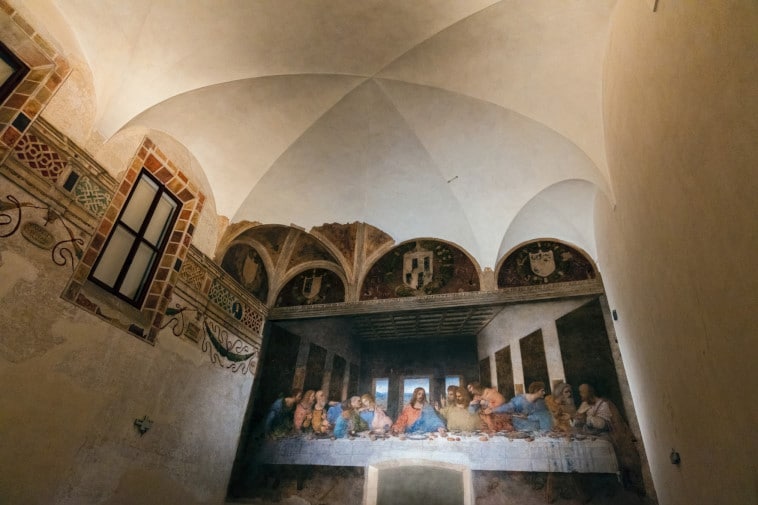Book your Last Supper Experience

The brilliance of Leonardo da Vinci shines through in his masterpiece, the Last Supper, making it a must-see for visitors in Milan. This iconic piece draws crowds from around the world, necessitating advance ticket purchase to ensure you don't miss out. However, securing tickets for the Last Supper in Milan can be more complex than expected.
Accessibility to visit Leonardo's famous Last Supper are extremely few. Only 35 visitors per 15 minutes are admitted. Ordinarily, The Last Supper tickets are priced at €15 per person and Last Supper tours are priced at a minimum of €50 per person for 2024. Booking tickets in advance is obligatory, and bookings can exclusively be made online or via the call centre at +39 02 9280 0360, since the on-site ticket office is just designated for confirming your reservation. The Last Supper tickets, typically made available one month in advance for a three-month period, are highly sought-after and often sell out. For example, tickets for 01 November 2024 to 31 January 2025 can be reserved around 30 days in advance, starting from 24 September 2024.
In addition to the above information, we would like to point out that it is also possible to visit the Last Supper by night. On selected days twice a month, the Last Supper gates are open from 7 pm to 10 pm, with the last admission at 9.45 pm. Late-night visits are in high demand and must be booked in advance. (you can check our web page for updates).
If you want to secure your visit two months in advance or face a sold-out situation, it may be worth considering a Last Supper tour, which conveniently includes the ticket cost in the overall price. This combination often doesn't result in a significant cost increase, particularly when it includes visits to other Milan attractions. You can use our webpage as a reliable source to compare all available options for Last Supper tickets, Last Supper tours and Milan tours including Last Supper.
Update for today: As of 21.10.2024 all official tickets are sold out.
from €15.00 EUR
Closest Date: All tickets are sold out
Duration: 15 Minutes
Organized by: Cenacolo Vinciano Vivaticket
from €90.00 EUR
Closest Date: October 24
Duration: 3 Hours
Organized by: Wander Italy
4.765 Reviews
from €76.50 EUR
Closest Date: November 1
Organized by: Towns of Italy
985 Reviews
from €89.00 EUR
Closest Date: October 26
Duration: 1 hour
Seller: Tiqets
96 Reviews
from €90.00 EUR
Closest Date: November 7
Duration: 3 Hours
Organized by: Veditalia
1.061 Reviews
from €99.00 EUR
Closest Date: October 22
Duration: 3.5 Hours
Organized by: Zani Viaggi Srl
1.839 Reviews
from €135.00 EUR
Closest Date: October 22
Duration: 6 Hours
Organized by: Veditalia
550 Reviews
from €99.00 EUR
Closest Date: October 23
Duration: 3.5 Hours
Seller: Tiqets
228 Reviews
from €159.00 EUR
Closest Date: October 24
Duration: 3 Hours
Organized by: LivItaly Tours LLC
26 Reviews
from €82.00 EUR
Closest Date: November 7
Duration: 2 Hours
Organized by: New Age
924 Reviews
from €134.00 EUR
Closest Date: October 24
Duration: 6 Hours
Organized by: Wander Italy
176 Reviews
from €340.00 EUR
Closest Date: October 25
Duration: 3 hours
Organized by: Memento | Italy In Style
117 Reviews
from €129.00 EUR
Closest Date: October 29
Duration: 45 min.
Organized by: LivItaly Tours LLC
394 Reviews
About Leonardo da Vinci's Last Supper
Santa Maria delle Grazie is one of the most beautiful churches in Italy. It was built in the 15th century, initially in the late Gothic style, and was rebuilt in the Renaissance style from 1492 by Bramante (1444 -1514). The highlight of the church is the fresco "The Last Supper" by Leonardo da Vinci (1452 -1519). It is considered one of the greatest masterpieces in the history of art and captures the moment when Jesus speaks the words: "One of you will betray me". The entrance to what used to be the refectory of the Dominican convent is in the square in front of Santa Maria delle Grazie. It is in this refectory that, between 1495 and 1497, Leonardo da Vinci painted the Last Supper.

The painting occupies all of the wall at the end of the refectory; in the three lunettes over the fresco, below the decorations of the vault (which was destroyed in 1943) are the coats of arms of the Sforza and the Este families surrounded by wreaths, a tribute to Duke Ludovico il Moro and his wife, Beatrice d'Este. Some scholars maintain that the scene by Leonardo of the twelve Apostles seated together with their Lord at the supper table portrays them at the moment when Jesus announced that one of them would betray him, or, as others say, at the moment of the Consecration.
The reaction of the Disciples is apparent from their exaggerated gestures, emotional movements, and facial expressions, and contrasts with the immobility of Christ who dominates the scene from the center of a rigorously symmetrical composition in perfect perspective. The whole scene seems to be bathed in a diffused, gentle light coming partly from the three windows at the far end of the room and partly from the light at the front from the actual window in the real room. The figures are one third bigger than life-size and show masterly particulars of execution: after having done the sketches by pen and outlining the figures in their various poses, Leonardo drew naked figures which he later dressed with color. The painting is done in tempera- forte with a technique that allowed an exquisite fineness in the passage of tones due to the perfect mixing of colors. On the opposite wall, in front of the “Last Supper”, is the great “Crucifixion” painted in fresco by Donato Montorfano in 1495.

The painting was miraculously left undamaged by the bombings of August 1943 which partially destroyed the nearby cloisters and parts of the church. The great painting has always been in a precarious state of conservation, and even Leonardo himself, when he had finished the work, declared that the work suffered from the humidity of the ground on which the building stood. Since 1517 it has steadily deteriorated, mainly because of the new painting technique used by Leonardo as an experiment. When a door was opened up in the wall, one of Christ’s legs was cut, while the restorations carried out in 1726 and 1770 only helped to increase the instability of the colors. At the time of Napoleon, the refectory was used as a stable and in 1801 was flooded by water. In 1953 the fresco was cleaned and consolidated; a complex and radical restoration procedure was completed in the second half of the 1990's so that this marvelous work can now be seen by the public again.
Milan Museum Tickets
Explore the vibrant art and culture scene in Milan with our comprehensive guide to the city's most popular museums. Find the perfect ticket or tour tailored to your interests, as we showcase options with the highest ratings and greatest number of reviews. Our selection includes world-renowned attractions such as the iconic Last Supper, La Scala Opera House, and the Sforza Castle. Don't miss out on these top-rated experiences – make your visit to Milan truly unforgettable with our expertly curated museum tickets and tours.
from €26.00 EUR
Validity: 3 Days
Organized by: Veneranda Fabbrica Duomo di Milano
40.357 Reviews
from €15.00 EUR
Seller: Tiqets
321 Reviews
from €14.00 EUR
Seller: Tiqets
128 Reviews
from €18.50 EUR
Seller: Tiqets
282 Reviews
from €39.00 EUR
Duration: 1 Hour
Organized by: Z V SRL
2.294 Reviews
Guided Milan Tours
Explore the best of Milan with our handpicked selection of popular tours, carefully curated based on user ratings and reviews. These top-rated experiences offer an in-depth look at the city's rich history, culture, and stunning architecture, ensuring a memorable trip for every traveler. Our list showcases tours that have garnered high praise from participants, with a proven track record of both excellent ratings and numerous reviews. Immerse yourself in the beauty and charm of Milan as you embark on these highly recommended guided tours, and let the city's allure captivate you.
from €145.00 EUR
Duration: 2.5 Hours
Organized by: Your Travel Diary
16 Reviews
from €22.50 EUR
Duration: 1 Day-48 Hours
Organized by: Sightseeing Experience
4.093 Reviews
from €25.00 EUR
Organized by: Zani Viaggi
170 Reviews
from €69.00 EUR
Duration: 2-3 Hours
Organized by: Fat Tire Tours – Italy
384 Reviews
from €99.00 EUR
Duration: 3 Hours
Organized by: Florencetown
473 Reviews
from €140.00 EUR
Duration: 2 hours
Organized by: Keys Of Italy / Milan and Venice
16 Reviews
from €40.50 EUR
Duration: 1 day
Seller: Tiqets
251 Reviews
from €72.00 EUR
Duration: 2 hours
Organized by: Wander Italy
811 Reviews
from €52.90 EUR
Duration: 8 hours
Organized by: Italy Hidden Experiences
22 Reviews
Day Trips from Milan
Explore the best day trips from Milan and make the most of your Italian adventure. Our carefully curated selection showcases the highest-rated and most popular excursions, ensuring you experience top-notch destinations. Popularity is determined by a combination of excellent user ratings and a high number of reviews, guaranteeing you a memorable journey. Whether you're seeking historic landmarks, stunning landscapes, or culinary delights, these day trips promise to surpass your expectations and create lasting memories. Uncover the gems surrounding Milan and enrich your travel experience.
from €99.00 EUR
Duration: 10 Hours
Organized by: Autostradale Viaggi
9.035 Reviews
from €149.00 EUR
Duration: 12.5 Hours
Organized by: Zani Viaggi Srl
1.329 Reviews
from €99.00 EUR
Duration: 12 Hours
Organized by: Z V SRL
204 Reviews
from €129.00 EUR
Duration: 14 hours
Organized by: Z V SRL
463 Reviews
from €139.00 EUR
Duration: 13 hours
Organized by: Z V SRL
123 Reviews
from €119.00 EUR
Duration: 12 Hours
Organized by: Z V SRL
287 Reviews
from €139.00 EUR
Duration: 13 hours
Organized by: Z V SRL
573 Reviews
from €690.00 EUR
Duration: 10 hours
Organized by: Memento Italy
3 Reviews
from €79.00 EUR
Duration: 9 hours
Organized by: Z V SRL
3 Reviews
from €139.00 EUR
Duration: 1 Day
Organized by: Z V SRL
19 Reviews
Transport Tickets
from €10.00 EUR
Seller: Tiqets
62 Reviews
from €5.00 EUR
Seller: Tiqets
82 Reviews
from €10.00 EUR
Seller: Tiqets
156 Reviews
